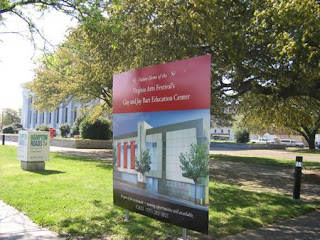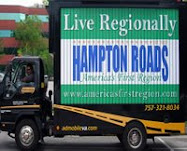 A weekly compilation of information impacting Hampton Roads military and federal capabilities, from the Hampton Roads Military and Federal Facilities Alliance.
A weekly compilation of information impacting Hampton Roads military and federal capabilities, from the Hampton Roads Military and Federal Facilities Alliance.
Mullen: Drones Future Stalwart of U.S. Force (
DefenseNews.com, May 14, 2009) Unmanned aircraft likely represent the future for U.S. military aviation, with next generation bombers and fighter planes operating without pilots onboard, the top U.S. military officer said. “We’re at a real time of transition here in terms of the future of aviation, and the whole issue of what is going to be manned and what is going to be unmanned,” Adm. Mike Mullen, chairman of the Joint Chiefs of Staff, told a Senate hearing.
Defense Secy. Gates Repeats Support for Mayport Move (
Virginian-Pilot, May 15, 2009) Local congressmen trying to halt the Navy’s plan to move an aircraft carrier from Norfolk, Va., to Mayport, Fla., got a reality check on Capitol Hill this week. Although the decision has been postponed, both Defense Secretary Robert M. Gates and Adm. Gary Roughead, chief of naval operations, made it clear in congressional testimony that they still think the move makes good strategic sense. The Pentagon said last month the issue would be studied as part of its upcoming Quadrennial Defense Review, delaying a final decision until 2011. Local members of Congress celebrated that announcement as a signal that Norfolk might be able to hang on to its five locally based carriers and their associated economic benefits. But this week’s testimony made it clear that top Pentagon officials have not changed their minds about the wisdom of the proposed move.
Navy: F-35 Fighter Jets Needed By 2015 Deadline (
WSJ.com, May 14, 2009) The chief of naval operations said that on-time delivery of Lockheed Martin’s next-generation Joint Strike Fighter will be critical in closing the gap of the fighter jets needed to match current and future threats. Adm. Gary Roughead told the House Armed Services Committee that the service’s current fleet of legacy F/A-18s from Boeing is rapidly aging and will need to be replaced quickly. Those jets have seen substantial action supporting forces on the ground in Iraq and Afghanistan.
San Antonio To Get AF Cyber Command (
San Antonio Express-News, May 15, 2009, Pg. 1) Lackland Air Force Base in San Antonio has been selected as the headquarters for a new cyber command, an official close to the process said, bringing an influx of infrastructure, security and 400 staffers. The official announcement was expected today. The headquarters will include the commander’s staff and an operations center that will focus on defending Air Force computers against attack and preventing disruptions.
Marshall, Mattis To Lead QDR 'Red Team' (
DefenseNews.com, May 15, 2009) U.S. Defense Secretary Robert Gates announced this week he has tapped two prominent defense thinkers to head the team that will challenge the conclusions of the 2010 Quadrennial Defense Review (QDR).
Mantra at U.S. Navy Budget Hearing: Wait for QDR (
DefenseNews.com, May 14, 2009) The Quadrennial Defense Review (QDR) due to be sent to Congress in February will answer many of today's questions, senior U.S. Navy and Marine Corps leaders told lawmakers May 14.
Last Manned Aircraft?: (
Airforce-Magazine.com, May 18, 2009) Despite eliminating the Air Force's next-generation bomber from the 2010 defense budget, Defense Secretary Robert Gates acknowledged it was his personal view that "we probably do need a follow-on bomber." But he told the Senate Armed Services Committee during May 14 testimony that much had changed since the 2006 Quadrennial Defense Review directed USAF to field the NGB by 2018. And, he now believes that the outcome of the new QDR and Nuclear Posture Review may provide different insight on that bomber and will question "whether, for example, the follow-on bomber needs to have a pilot in it." Adm. Michael Mullen, chairman of the Joint Chiefs of Staff, agreed, declaring, "There are those that see the JSF [F-35 Lightning II Joint Strike Fighter] as the last manned fighter—or fighter bomber or—or jet, and I'm one that's inclined to believe that." (The Air Force is slated to purchase the last of its 1,763 JSFs in 2034.) Mullen said, "We're at a real time of transition here in terms of the future of aviation, and the whole issue of what's going to be manned and what's going to be unmanned, what's going to be stealthy, what isn't, how do we address these threats … it's changing, even from 2006."
Gates Demands Review of U.S. Service Chiefs’ Wish Lists (
DefenseNews.com, May 18, 2009, Pg. 1) Defense Secretary Robert M. Gates, who issued a gag order as the 2010 budget request was being prepared, is now inserting himself into a process designed by Congress to promote candid answers from military leaders, raising members’ fears that they are not receiving enough information on defense spending. In April, Gates ordered the service chiefs to brief him on their unfunded requirements lists before they went to Congress. That briefing was set for May 15. “I have no problem with them putting together a list of unfundeds, but the law requires them to inform me about that list before they send it up here,” Gates told the Senate Armed Services Committee on May 14. “What I have tried to do ... is to bring some discipline to a budgetary process that, shall we say, lacked a certain measure of discipline in the past.”
Cash-Strapped Navy Puts Hold on Transfers, Goodwill Visits By Ships $930 Million Funding Backlog May Affect Service’s Readiness (
Honolulu Advertiser, May 17, 2009) A cash-strapped Navy has halted 14,000 duty station moves and is reducing by one-third the sailing time of non-deployed ships and cutting back on aviation flight hours and ship visits to U.S. cities to counter a $930 million ship repair and manpower budget shortfall, officials said. That funding backlog is being addressed by Congress; Sen. Daniel K. Inouye, chairman of the Senate Appropriations Committee, on Thursday added $190 million to a defense supplemental bill. The mid-year funds are intended to pay for repairs to the Pearl Harbor-based cruiser Port Royal, which ran aground in February off Honolulu airport, as well as to fix the submarine Hartford and amphibious ship New Orleans following their collision in March in the Strait of Hormuz. Inouye also increased Navy personnel funding by $230 million to address a $350 million manpower-cost shortfall, officials said. The Navy expects to recoup about $89 million with the duty station freeze, the Navy Times reported.
140,000 more feds next year (
FederalTimes.com, May 18, 2009) by Stephen Losey
The executive branch will grow to more than 2 million civilian employees for the first time in 15 years, under President Barack Obama’s 2010 budget plan. The growing ranks of government employees reflect the ever-growing responsibilities many agencies are taking on and the different priorities President Obama has from his predecessor: The Defense Department’s workforce will grow by about 19,000 full-time equivalent positions, most of which will come from converting — or “insourcing” — about 13,800 contractor jobs to federal employee jobs. This is the largest staffing increase proposed for next year, aside from Commerce.
No Tricare Fee Hike: (
Airforce-Magazine.com, May 18, 2009) The Fiscal 2010 defense budget does not—repeat does not—contain a provision to increase the Tricare fees for retired military personnel, unlike the past three defense budgets in which the Bush Administration tried to raise fees as one means to offset higher healthcare costs.
Housing Relief: (
Airforce-Magazine.com, May 18, 2009) The Defense Department has temporarily expanded the Housing Assistance Program with a $555 million boost from the American Recovery and Reinvestment Act to help military members who have trouble selling their primary residence in the midst of the economic downturn. That means those members at bases undergoing BRAC 2005-directed drawdowns don't have to prove the BRAC action drove the local housing market down.
Congress Will Make Own Shipbuilding Plan: Lawmaker (
DefenseNews.com, May 15, 2009) The U.S. Navy's new shipbuilding budget faced a focused round of congressional scrutiny May 15, absent a familiar element: the 30-year fleet plan that generates a central part of the annual debate.
Ex-Gov. Mabus Sworn in as New Navy Secretary (
Jackson Clarion-Ledger, May 20, 2009) Former Mississippi Gov. Ray Mabus has been sworn in as the secretary of the Navy, putting him in a key post in the new administration. “He’s going to be a very good choice,” said Loren Thompson, a defense analyst with the Lexington Institute, because Mabus has a close relationship with President Obama and a good understanding of global diplomacy. But it is Mabus’ political skills that will be particularly useful in his new role, Thompson said.
Lawmakers Say Air Force Plane Cuts May Be Too Deep (
WashingtonPost.com, May 19, 2009) House lawmakers say the Air Force could end up flat-footed if it carries out plans to end big programs like the C-17 cargo plane and retires fighter jets while waiting for new ones that are still being tested. The Air Force’s roughly $115.6 billion 2010 base budget request includes a significant shift in weapons buying, ending some politically popular but expensive programs like the C-17 and the F-22 fighter plane. It calls for retiring roughly 250 fighter jets on an accelerated schedule in anticipation of building up its fleet of F-35s from Lockheed Martin. But members of the House Armed Services Committee on Tuesday questioned whether that leaves the Air Force with enough planes to perform its mission. They cited other proposed changes, like halving the number of planned C-27 cargo jets and scrapping current plans to build a new long range bomber.
Air Force's "Underfunded" Priorities: (
Airforce-Magazine.com, May 18, 2009) The Air Force's wish-list of some 20 additional items not included in its Fiscal 2010 budget request landed on Capitol Hill Monday evening. Noteworthy is the fact that the list adds up to slightly more than $1.9 billion, less than a tenth of last year's $20 billion list of unfunded priorities.
Chambliss: Hill Leaders 'Realize 187 F-22s Is Not Enough' (
DefenseNews.com, May 20, 2009) Congressional proponents of more F-22 fighters will aim to put extra money for the stealthy jets in the 2010 U.S. defense appropriations bill, a key senator says.
Lest There Be Any Doubt: (
InsideDefense.com, May 20, 2009) During a May 19 House Armed Services Committee budget hearing, several lawmakers questioned Gen. Norton Schwartz, Chief of Staff, about curtailment of F-22 production at only 187 aircraft and insistence by DOD officials that those 187 aircraft met military need. In one instance, Schwartz's response was short and sweet: "Two forty-three is the right number and 187 is the affordable force."
Current QDR Will Push Gates' Reshaping: (
Airforce-Magazine.com, May 20, 2009) Irregular warfare and counterinsurgency capabilities not surprisingly are among key focus areas to be scrutinized in the just-commenced Quadrennial Defense Review, Undersecretary of Defense for Policy Michele Flournoy told the Defense Writers Group Wednesday morning. Flournoy acknowledged that this QDR will be a "leader driven process" that involves Defense Secretary Robert Gates, Deputy Defense Secretary William Lynn, and other senior leadership. One thing that makes this QDR unique, said Flournoy, is that it is jumping off from an established National Defense Strategy, the one Gates released last year. In fact, she said, there is a "pretty clear consensus internally and interagency" on guidance and priorities and that this QDR will inform program and budget decisions. She added, "This is not some separate process; this is creating a strategic framework to drive that process." Flournoy also acknowledged that the rebalancing Gates started with the Fiscal 2010 budget proposal will move forward under this review. She expects various working groups to complete their work by the end of the summer, making it possible for the QDR insights to help "frame and guide decision making" for the 2011 program objective memorandum.
DoD Official: QDR Will Lead To Further ‘Rebalancing’ of Weapons in FY ‘11 (
DefenseDaily.com, May 21, 2009) The Pentagon leadership is “very consciously” moving to implement further program changes in the fiscal year 2011 budget cycle using the latest round of a major weapons portfolio review conducted every four years, a top Defense Department official said. Michele Flournoy, undersecretary of defense for policy, said this year’s Quadrennial Defense Review will have more practical ramifications for the Pentagon’s budget than QDRs of years past have had. “This is not some separate process,” Flournoy told defense reporters. “This is creating the strategic framework that will drive” fiscal 2011 budget priorities.
F-22 Adequate for One, not Two, MCOs: (
Airforce-Magazine.com, May 20, 2009) Sen. Saxby Chambliss (R-Ga.)—the Senate's leading defender of the F-22 program and vocal critic of its cancellation—asked Chief of Staff Gen. Norton Schwartz during Thursday's Senate Armed Services Committee hearing on the Air Force 2010 budget proposal to characterize the amount of risk inherent with a program-of-record for only 183 Raptors. He asked: "What is the level of risk that we are taking at 183? Is it low, is it moderate, or is it high risk?" Schwartz replied, "I would characterize it as moderate to high." However, he added that his analysis was based on a standard two Major Combat Operations scenario set forth in past Quadrennial Defense Reviews. That two-MCO construct may well get thrown out in the new QDR being orchestrated now by Defense Secretary Robert Gates. Schwartz continued, "There is no question that the program is adequate for one major combat operation."
Musical Chairs: (
ShreveportTimes.com, May 22, 2009) According to a report in the Shreveport Times, Gen. William Fraser III, currently serving as the Vice Chief of Staff, is the likely successor to head Air Combat Command when Gen. John Corley retires this summer.
Washington, DC – House Armed Services Committee Chairman Ike Skelton (D-MO) delivered remarks during House debate on the conference report to S. 454, the Weapon Systems Acquisition Reform Act of 2009. The U.S. House of Representatives approved the conference report on a vote of 411 to 0. (
House Armed Services Committee website, May 21, 2009) “In the area of policy, we require DOD to balance its desire for cutting edge capabilities with the limits of its resources in setting military requirements. We require competitive acquisition strategies. We require DOD to get programs right in the early stages, when problems can be solved at low cost. We also require DOD to put intense management focus on problem programs until they are either healed, or terminated. We strengthen the Nunn-McCurdy process. And we ask DOD to eliminate or mitigate organizational conflicts of interests among its contractors.”































































